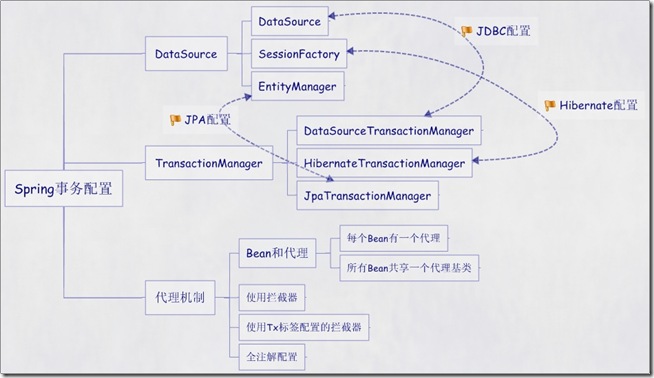写在前面:本博文为网络资源,文章后面有参考链接,写本文的目的是博主在利用 Hibernate + Spring 连接数据库进行数据更改时发现事物不能被提交,在经历了一个下午的各种折腾之后发现原因是当利用 Spring 接管事物时,Hibernate的 hibernate.cfg.xml 配置文件中的
1 <property name ="current_session_context_class" > thread</property >
应该注释掉,否则spring无法接管,希望后人少走弯路。
Spring声明式事务配置的五种方式 Spring配置文件中关于事务配置总是由三个组成部分,分别是DataSource、TransactionManager和代理机制这三部分,无论哪种配置方式,一般变化的只是代理机制这部分。
DataSource、TransactionManager这两部分只是会根据数据访问方式有所变化,比如使用Hibernate进行数据访问时,DataSource实际为SessionFactory,TransactionManager的实现为HibernateTransactionManager。
具体如下图:
根据代理机制的不同,总结了五种Spring事务的配置方式,配置文件如下:
第一种方式:每个Bean都有一个代理 1 2 3 4 5 6 7 8 9 10 11 12 13 14 15 16 17 18 19 20 21 22 23 24 25 26 27 28 29 30 31 32 33 34 35 36 37 38 <?xml version="1.0" encoding="UTF-8"?> <beans xmlns ="http://www.springframework.org/schema/beans" xmlns:xsi ="http://www.w3.org/2001/XMLSchema-instance" xmlns:context ="http://www.springframework.org/schema/context" xmlns:aop ="http://www.springframework.org/schema/aop" xsi:schemaLocation ="http://www.springframework.org/schema/beans http://www.springframework.org/schema/beans/spring-beans-2.5.xsd http://www.springframework.org/schema/context http://www.springframework.org/schema/context/spring-context-2.5.xsd http://www.springframework.org/schema/aop http://www.springframework.org/schema/aop/spring-aop-2.5.xsd" > <bean id ="sessionFactory" class ="org.springframework.orm.hibernate3.LocalSessionFactoryBean" > <property name ="configLocation" value ="classpath:hibernate.cfg.xml" /> <property name ="configurationClass" value ="org.hibernate.cfg.AnnotationConfiguration" /> </bean > <bean id ="transactionManager" class ="org.springframework.orm.hibernate3.HibernateTransactionManager" > <property name ="sessionFactory" ref ="sessionFactory" /> </bean > <bean id ="userDaoTarget" class ="com.bluesky.spring.dao.UserDaoImpl" > <property name ="sessionFactory" ref ="sessionFactory" /> </bean > <bean id ="userDao" class ="org.springframework.transaction.interceptor.TransactionProxyFactoryBean" > <property name ="transactionManager" ref ="transactionManager" /> <property name ="target" ref ="userDaoTarget" /> <property name ="proxyInterfaces" value ="com.bluesky.spring.dao.GeneratorDao" /> <property name ="transactionAttributes" > <props > <prop key ="*" > PROPAGATION_REQUIRED</prop > </props > </property > </bean > </beans >
第二种方式 1 2 3 4 5 6 7 8 9 10 11 12 13 14 15 16 17 18 19 20 21 22 23 24 25 26 27 28 29 30 ...... <bean id ="sessionFactory" class ="org.springframework.orm.hibernate3.LocalSessionFactoryBean" > <property name ="configLocation" value ="classpath:hibernate.cfg.xml" /> <property name ="configurationClass" value ="org.hibernate.cfg.AnnotationConfiguration" /> </bean > <bean id ="transactionManager" class ="org.springframework.orm.hibernate3.HibernateTransactionManager" > <property name ="sessionFactory" ref ="sessionFactory" /> </bean > <bean id ="transactionBase" class ="org.springframework.transaction.interceptor.TransactionProxyFactoryBean" lazy-init ="true" abstract ="true" > <property name ="transactionManager" ref ="transactionManager" /> <property name ="transactionAttributes" > <props > <prop key ="*" > PROPAGATION_REQUIRED</prop > </props > </property > </bean > <bean id ="userDaoTarget" class ="com.bluesky.spring.dao.UserDaoImpl" > <property name ="sessionFactory" ref ="sessionFactory" /> </bean > <bean id ="userDao" parent ="transactionBase" > <property name ="target" ref ="userDaoTarget" /> </bean >
第三种方式:使用拦截器 1 2 3 4 5 6 7 8 9 10 11 12 13 14 15 16 17 18 19 20 21 22 23 24 25 26 27 28 29 30 31 32 33 34 35 36 37 38 ...... <bean id ="sessionFactory" class ="org.springframework.orm.hibernate3.LocalSessionFactoryBean" > <property name ="configLocation" value ="classpath:hibernate.cfg.xml" /> <property name ="configurationClass" value ="org.hibernate.cfg.AnnotationConfiguration" /> </bean > <bean id ="transactionManager" class ="org.springframework.orm.hibernate3.HibernateTransactionManager" > <property name ="sessionFactory" ref ="sessionFactory" /> </bean > <bean id ="transactionInterceptor" class ="org.springframework.transaction.interceptor.TransactionInterceptor" > <property name ="transactionManager" ref ="transactionManager" /> <property name ="transactionAttributes" > <props > <prop key ="*" > PROPAGATION_REQUIRED</prop > </props > </property > </bean > <bean class ="org.springframework.aop.framework.autoproxy.BeanNameAutoProxyCreator" > <property name ="beanNames" > <list > <value > *Dao</value > </list > </property > <property name ="interceptorNames" > <list > <value > transactionInterceptor</value > </list > </property > </bean > <bean id ="userDao" class ="com.bluesky.spring.dao.UserDaoImpl" > <property name ="sessionFactory" ref ="sessionFactory" /> </bean >
第四种方式:使用tx标签配置的拦截器 1 2 3 4 5 6 7 8 9 10 11 12 13 14 15 16 17 18 19 20 21 22 23 24 25 26 27 28 29 30 31 32 33 34 35 36 <?xml version="1.0" encoding="UTF-8"?> <beans xmlns ="http://www.springframework.org/schema/beans" xmlns:xsi ="http://www.w3.org/2001/XMLSchema-instance" xmlns:context ="http://www.springframework.org/schema/context" xmlns:aop ="http://www.springframework.org/schema/aop" xmlns:tx ="http://www.springframework.org/schema/tx" xsi:schemaLocation ="http://www.springframework.org/schema/beans http://www.springframework.org/schema/beans/spring-beans-2.5.xsd http://www.springframework.org/schema/context http://www.springframework.org/schema/context/spring-context-2.5.xsd http://www.springframework.org/schema/aop http://www.springframework.org/schema/aop/spring-aop-2.5.xsd http://www.springframework.org/schema/tx http://www.springframework.org/schema/tx/spring-tx-2.5.xsd" > <context:annotation-config /> <context:component-scan base-package ="com.bluesky" /> <bean id ="sessionFactory" class ="org.springframework.orm.hibernate3.LocalSessionFactoryBean" > <property name ="configLocation" value ="classpath:hibernate.cfg.xml" /> <property name ="configurationClass" value ="org.hibernate.cfg.AnnotationConfiguration" /> </bean > <bean id ="transactionManager" class ="org.springframework.orm.hibernate3.HibernateTransactionManager" > <property name ="sessionFactory" ref ="sessionFactory" /> </bean > <tx:advice id ="txAdvice" transaction-manager ="transactionManager" > <tx:attributes > <tx:method name ="*" propagation ="REQUIRED" /> </tx:attributes > </tx:advice > <aop:config > <aop:pointcut id ="interceptorPointCuts" expression ="execution(* com.bluesky.spring.dao.*.*(..))" /> <aop:advisor advice-ref ="txAdvice" pointcut-ref ="interceptorPointCuts" /> </aop:config > </bean >
第五种方式: 1 2 3 4 5 6 7 8 9 10 11 12 13 14 15 ...... <context:annotation-config /> <context:component-scan base-package ="com.bluesky" /> <tx:annotation-driven transaction-manager ="transactionManager" /> <bean id ="sessionFactory" class ="org.springframework.orm.hibernate3.LocalSessionFactoryBean" > <property name ="configLocation" value ="classpath:hibernate.cfg.xml" /> <property name ="configurationClass" value ="org.hibernate.cfg.AnnotationConfiguration" /> </bean > <bean id ="transactionManager" class ="org.springframework.orm.hibernate3.HibernateTransactionManager" > <property name ="sessionFactory" ref ="sessionFactory" /> </bean >
此时在DAO上需加上@Transactional注解,如下:
1 2 3 4 5 6 7 8 @Transactional @Component("userDao") public class UserDaoImpl extends HibernateDaoSupport implements UserDao { public List<User > listUsers() { return this.getSession().createQuery("from User").list(); } ...... }
事务的传播属性(Propagation) Propagation :key属性确定代理应该给哪个方法增加事务行为。这样的属性最重要的部份是传播行为。有以下选项可供使用:PROPAGATION_REQUIRED–支持当前事务,如果当前没有事务,就新建一个事务。这是最常见的选择。PROPAGATION_REQUIRED–支持当前事务,如果当前没有事务,就新建一个事务。这是最常见的选择。PROPAGATION_SUPPORTS–支持当前事务,如果当前没有事务,就以非事务方式执行。PROPAGATION_MANDATORY–支持当前事务,如果当前没有事务,就抛出异常。PROPAGATION_REQUIRES_NEW–新建事务,如果当前存在事务,把当前事务挂起。PROPAGATION_NOT_SUPPORTED–以非事务方式执行操作,如果当前存在事务,就把当前事务挂起。PROPAGATION_NEVER–以非事务方式执行,如果当前存在事务,则抛出异常。
1: PROPAGATION_REQUIRED
2: PROPAGATION_SUPPORTS
3: PROPAGATION_MANDATORY
4: PROPAGATION_REQUIRES_NEW
5: PROPAGATION_NOT_SUPPORTED
6: PROPAGATION_NEVER
7: PROPAGATION_NESTED
而Nested事务的好处是他有一个savepoint。
1 2 3 4 5 6 7 8 9 10 11 ServiceA { void methodA () try { ServiceB.methodB(); } catch (SomeException) { } } }
也就是说ServiceB.methodB失败回滚,那么ServiceA.methodA也会回滚到savepoint点上,ServiceA.methodA可以选择另外一个分支,比如ServiceC.methodC,继续执行,来尝试完成自己的事务。但是这个事务并没有在EJB标准中定义。
Spring事务的隔离级别(Isolation level) 由隔离级别从低到高:
ISOLATION_DEFAULT:这是一个PlatfromTransactionManager默认的隔离级别,使用数据库默认的事务隔离级别。
ISOLATION_READ_UNCOMMITTED:这是事务最低的隔离级别,它充许令外一个事务可以看到这个事务未提交的数据。
ISOLATION_READ_COMMITTED: 保证一个事务不能读到另一个并行事务已修改但未提交的数据。数据提交后才能被读取。
避免了脏数据。该级别适应于大多数系统。大多数主流数据库默认的级别。
什么是脏数据,脏读,不可重复读,幻觉读? 脏读: 指当一个事务正在访问数据,并且对数据进行了修改,而这种修改还没有提交到数据库中,这时,另外一个事务也访问这个数据,然后使用了这个数据。因为这个数据是还没有提交的数据,那么另外一个事务读到的这个数据是脏数据,依据脏数据所做的操作可能是不正确的。
不可重复读: 指在一个事务内,多次读同一数据。在这个事务还没有结束时,另外一个事务也访问该同一数据。 那么,在第一个事务中的两次读数据之间,由于第二个事务的修改,那么第一个事务两次读到的数据可能是不一样的。这样就发生了在一个事务内两次读到的数据是不一样的,因此称为是不可重复读。
幻觉读: 指当事务不是独立执行时发生的一种现象,例如第一个事务对一个表中的数据进行了修改,这种修改涉及到表中的全部数据行。同时,第二个事务也修改这个表中的数据,这种修改是向表中插入一行新数据。那么,以后就会发生操作第一个事务的用户发现表中还有没有修改的数据行,就好象发生了幻觉一样。
不可重复读与幻觉读区别:幻觉读与不可重复读有点相似,但是不可重复读读取的数据不一致是因为他所要取的数据集被改变了。但是phantom reads所要读的数据的不一致却不是他所要读的数据集改变,而是他的条件数据集改变。比如Select account.id where account.name=”ppgogo*”,第一次读去了6个符合条件的id,第二次读取的时候,由于事务b把一个帐号的名字由”dd”改成”ppgogo1”,结果取出来了7个数据。
一个完整的常用的配置方便的事务配置例子 1 2 3 4 5 6 7 8 9 10 11 12 13 14 15 16 17 18 19 20 21 22 23 24 25 26 <bean id ="dataSource" class ="com.mchange.v2.c3p0.ComboPooledDataSource" destroy-method ="close" > <property name ="driverClass" value ="${driverClass}" > </property > <property name ="jdbcUrl" value ="${jdbcUrl}" > </property > <property name ="user" value ="${user}" > </property > <property name ="password" value ="${password}" > </property > </bean > <bean id ="transactionManager" class ="org.springframework.orm.hibernate3.HibernateTransactionManager" > <property name ="sessionFactory" ref ="sessionFactory" /> </bean > <tx:advice id ="txAdvice" transaction-manager ="transactionManager" > <tx:attributes > <tx:method name ="*" propagation ="REQUIRED" isolation ="DEFAULT" read-only ="true" timeout ="-1" /> </tx:attributes > </tx:advice > <aop:config > <aop:pointcut id ="pointcutId" expression ="execution(* com.google.code..*.*Service.*(..))" /> <aop:advisor advice-ref ="txAdvice" pointcut-ref ="pointcutId" /> </aop:config >
注: 以上内容转自 http://www.cnblogs.com/hellojava/archive/2012/11/21/2780694.html


